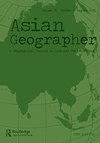“世越号”沉船事故后,治疗空间如何有助于修复人际关系?
IF 2.2
Q2 GEOGRAPHY
引用次数: 0
摘要
本研究探讨了以治疗空间为中心建立稳定人际关系的努力如何帮助当地社区在世越号沉船事故后应对或调整。在这场灾难之后,受灾社区的各种人际关系被破坏了。韩国政府和民间团体(ngo)设立了7个治疗空间,帮助人们恢复这种关系。本文主要关注非政府组织的治疗空间,它们具有显著的共同特征。首先,每个治疗空间都鼓励被照顾者将他们的注意力从灾难导致的死亡的罪恶感中转移出来,并通过非语言活动恢复个人与自己的关系。其次,这些空间试图通过治疗性的接触和干预来恢复个人与他人的关系,这些接触和干预体现了对海难直接和间接受害者的无条件奉献、真诚和理解。第三,这些空间建立了一个治疗网络,从而共享接受者的信息,协调每个居民的融合。第四,这些共享空间在社区中创造并加强了互惠、奉献和人道的道德框架,从而增强了社会意识和同理心。换句话说,这些空间形成了一种治愈文化,使韩国人对社会问题更加敏感,并帮助人们朝着积极的方向前进。本文章由计算机程序翻译,如有差异,请以英文原文为准。
How do therapeutic spaces contribute to repairing human relationships after the MV Sewol shipwreck?
ABSTRACT This study examines how efforts to establish stable human relationships centered on therapeutic spaces helped a local community cope or adjust after the MV Sewol shipwreck. In the wake of this disaster, various human relationships in the affected community were shattered. The Korean government and non-governmental organizations (NGOs) set up seven therapeutic spaces to help people restore these relationships. This paper focuses mainly on NGOs’ therapeutic spaces, which share significant common characteristics. First, each therapeutic space encourages care recipients to divert their attention away from their sense of guilt regarding deaths resulting from the disaster and restore the individual's relationship with themselves through nonverbal activities. Second, the spaces try to recover individuals’ relationships with others through therapeutic encounters and interventions that embody unconditional devotion, sincerity, and understanding for both direct and indirect victims of the shipwreck. Third, these spaces establish a therapeutic network, thereby sharing recipient information and coordinating the integration of each resident. Fourth, these shared spaces created and reinforced a moral framework of reciprocity, dedication, and humanity in the community, thereby enhancing social awareness and empathy. In other words, these spaces forged a healing culture that made Koreans more sensitive to social issues and helped people move in a positive direction.
求助全文
通过发布文献求助,成功后即可免费获取论文全文。
去求助
来源期刊

Asian Geographer
GEOGRAPHY-
CiteScore
3.30
自引率
0.00%
发文量
7
期刊介绍:
Asian Geographer disseminates knowledge about geographical problems and issues focusing on Asia and the Pacific Rim. Papers dealing with other regions should have a linkage to Asia and the Pacific Rim. Original and timely articles dealing with any field of physical or human geographical inquiries and methodologies will be considered for publication. We welcome, for example, submissions on people-environment interactions, urban and regional development, transport and large infrastructure, migration, natural disasters and their management, environment and energy issues. While the focus of the journal is placed on original research articles, review papers as well as viewpoints and research notes under the category of “Asian Geography in Brief” are also considered. Review papers should critically and constructively analyse the current state of understanding on geographical and planning topics in Asia. The ‘Asian Geography in Brief’ section welcomes submissions of applied geographical and planning research about Asia. The section aims to showcase (1) the diverse geography and planning of Asia; and (2) the diverse geographical and planning research about Asia. The journal will also publish special issues on particular themes or areas. Book reviews can be included from time to time.
 求助内容:
求助内容: 应助结果提醒方式:
应助结果提醒方式:


